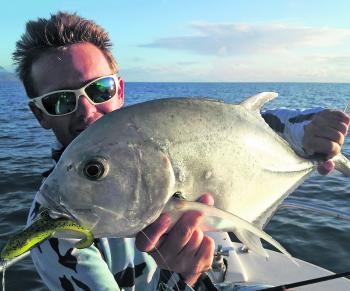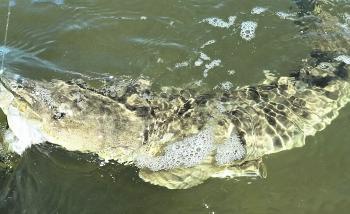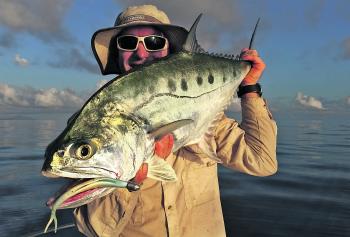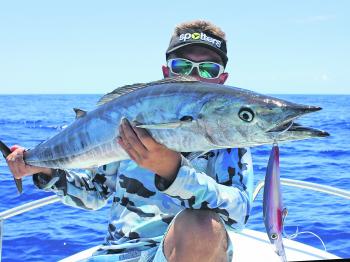It still amazes me how the water changes so quickly here in the tropics. It only took a week and the water temperature plummeted and you could watch your lure swimming to the bottom in 3m of water.
During winter, the fishing changes dramatically and gets difficult. Most of the fish at Lucinda love warm water that offer a degree of cover for them to hide and hunt their meals. It’s possible to have great sessions on barra and jacks on lures or baits, it’s just that these sessions will be rare, no matter the spots you know or your skill level. During the cool months, my thoughts go straight to chasing pelagic fish and I can almost smell the braid ripping off my spool.
I still can’t get used to chasing little mackerel when up the channel. Spots that I would fish for barra during the wet season now have massive schools of bait and are being harassed by small mackerel. The best time for this action is at first light, and it’s as easy as motoring slowly up the channel looking closely for the water rippling with bait or birds diving.
Slowly creeping up on these schools and throwing small metal slices or poppers should see you hooked up and having a ball. There will also be some monster queenfish and GT hanging about, so lobbing a big popper through the school can provide jaw-dropping moments.
Fishing the sand flat edges on the start of the incoming tide will also be rewarding with epic fun on small pocket size GT. There will be the odd bigger model about, but in general they will be between 1-3kg and ready to rip line of small spinning reels.
Birds diving can be a give away and on dead flat days you will be watch them carve through the bait schools. It is visual fishing and very hard to beat, as it’s possible for everybody in the boat to be hooked-up at the same time. Good quality spin gear with light braid is optimal for this style of fishing, as the ability to make long casts with small lures is key to getting strikes.
The humble flathead is not a glamour tropical species and its name rarely gets a mention, but during winter they are about in good numbers and are aggressive. Finding good drop-offs and holes in creeks is a good place to start.
Remember that flathead only need a few centimetres of water to cover themselves. They will lie covered in sand on the bottom waiting to ambush unsuspecting small fish or prawns.
The key to catching flathead is to make sure your lure or plastic keeps regular contact with the bottom. Flathead use their lateral lines to sense prey in the area, and having your plastic banging the bottom will get their attention.
I haven’t talked much about barra and jacks, but they are still about. They just get very slow and moody when it’s cold and clear. Small offerings worked very slowly and finding areas where the water is a little warmer will help. Fishing shallow mud flats is my normal go-to as the water stays warmer.
Small unweighted plastics fished erratically over the shallow mud should produce at least a swipe, you just have to hope it finds the hook.
Lucinda jetty is famous for big queenfish and during winter it’s not uncommon to see dozens of boats out and most of them will be hooked up and having a ball. Queenfish are underrated as a sportfish and the fact that they eat nearly anything should make them popular.
The best bite times are the mornings or afternoons and the incoming tide pushing clean water will fish the best. With the help of technology, it is very easy to locate the schools and if you have side-scan fish finders with an electric motor with spot lock, it’s almost unfair.
The best thing about queenfish is their willingness to chase down poppers. If you’re lucky enough to have the jetty to yourself or very few boats about, then having a popper session in the late afternoon is so much fun. Instead of a stop start blooping motion, use a fast retrieve that has the popper splattering across the surface. You will see them racing out in packs trying to smack it, and if they don’t seem to be interested, wind faster! Queenies get more excited the faster something goes and trust me, they will catch it!
The reef is all about chasing Spanish mackerel during winter. It’s a fun way to get a great feed for yourself and friends as Spaniards offer loads of top quality fillets. They can be caught in so many ways, but the simplest and probably most successful is slow trolling garfish. There are many pre-made rigs to rig them.
Trolling lures is also very effective and a couple of deep divers that can maintain their swimming action around 6-8km/h will get eaten.
Once you have found baitfish or mackerel, use plastic or slugs rigged on small wire traces – this is loads of fun and will test out your drag system.
Reads: 1310
ZMan Frogz aren’t just for smoothwaters, GTs also don’t seem to mind having a crack!

Flathead are the forgotten species in NQ, but they are great fun and taste great.

Queenfish offer hours of arm-stretching fun during winter.

Wahoo will be available out on the reefs with the Spaniards.




